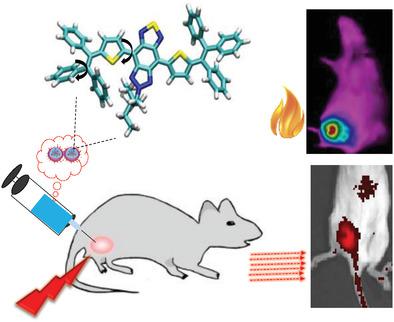当前位置:
X-MOL 学术
›
Adv. Funct. Mater.
›
论文详情
Our official English website, www.x-mol.net, welcomes your
feedback! (Note: you will need to create a separate account there.)
Organic Small Molecule Based Photothermal Agents with Molecular Rotors for Malignant Breast Cancer Therapy
Advanced Functional Materials ( IF 18.5 ) Pub Date : 2019-11-18 , DOI: 10.1002/adfm.201907093 Bing Guo 1 , Zemin Huang 2 , Qi Shi 1 , Eshu Middha 1 , Shidang Xu 1 , Ling Li 2 , Min Wu 1 , Jianwen Jiang 1 , Qinglian Hu 2 , Zhengwei Fu 2 , Bin Liu 1
Advanced Functional Materials ( IF 18.5 ) Pub Date : 2019-11-18 , DOI: 10.1002/adfm.201907093 Bing Guo 1 , Zemin Huang 2 , Qi Shi 1 , Eshu Middha 1 , Shidang Xu 1 , Ling Li 2 , Min Wu 1 , Jianwen Jiang 1 , Qinglian Hu 2 , Zhengwei Fu 2 , Bin Liu 1
Affiliation

|
Organic photothermal nanoagents are promising candidates for treating primary tumors and inhibiting metastasis. However, they often exhibit poor photostability, low absorptivity, or limited photothermal conversion efficiency (PCE). Herein, a facile molecular engineering approach to produce efficient organic photothermal molecules is demonstrated. By integrating donor–acceptor structure and molecular motors, a small molecule (TA1) is synthesized with large absorptivity (22.4 L g−1 cm−1), negligible reactive oxygen species generation, high PCE (84.8%), excellent photothermal stability, and good biocompatibility. Furthermore, microfluidics is used to thoroughly study the relationship between the size and process conditions, yielding small uniform nanoparticles (NPs) with a diameter of 44 nm. Importantly, TA1 NPs under near‐infrared laser irradiation significantly suppressed primary breast tumor growth and metastasis, both in vitro and in vivo. This study shows that small organic molecule nanoparticles are promising candidates for future cancer nanomedicine.
中文翻译:

基于有机小分子的分子转子光热剂用于恶性乳腺癌治疗
有机光热纳米剂是治疗原发肿瘤和抑制转移的有希望的候选者。但是,它们通常表现出较差的光稳定性,低吸收率或有限的光热转换效率(PCE)。在本文中,展示了一种生产有效有机光热分子的简便分子工程方法。通过整合供体-受体结构和分子马达,合成了具有大吸收率(22.4 L g -1 cm -1的小分子(TA1)),活性氧生成量可忽略不计,高PCE(84.8%),优异的光热稳定性和良好的生物相容性。此外,微流体用于彻底研究尺寸和工艺条件之间的关系,产生直径为44 nm的小的均匀纳米颗粒(NP)。重要的是,在体外和体内,近红外激光照射下的TA1 NPs均能显着抑制原发性乳腺肿瘤的生长和转移。这项研究表明,小的有机分子纳米颗粒是未来癌症纳米医学的有希望的候选者。
更新日期:2020-01-29
中文翻译:

基于有机小分子的分子转子光热剂用于恶性乳腺癌治疗
有机光热纳米剂是治疗原发肿瘤和抑制转移的有希望的候选者。但是,它们通常表现出较差的光稳定性,低吸收率或有限的光热转换效率(PCE)。在本文中,展示了一种生产有效有机光热分子的简便分子工程方法。通过整合供体-受体结构和分子马达,合成了具有大吸收率(22.4 L g -1 cm -1的小分子(TA1)),活性氧生成量可忽略不计,高PCE(84.8%),优异的光热稳定性和良好的生物相容性。此外,微流体用于彻底研究尺寸和工艺条件之间的关系,产生直径为44 nm的小的均匀纳米颗粒(NP)。重要的是,在体外和体内,近红外激光照射下的TA1 NPs均能显着抑制原发性乳腺肿瘤的生长和转移。这项研究表明,小的有机分子纳米颗粒是未来癌症纳米医学的有希望的候选者。




















































 京公网安备 11010802027423号
京公网安备 11010802027423号